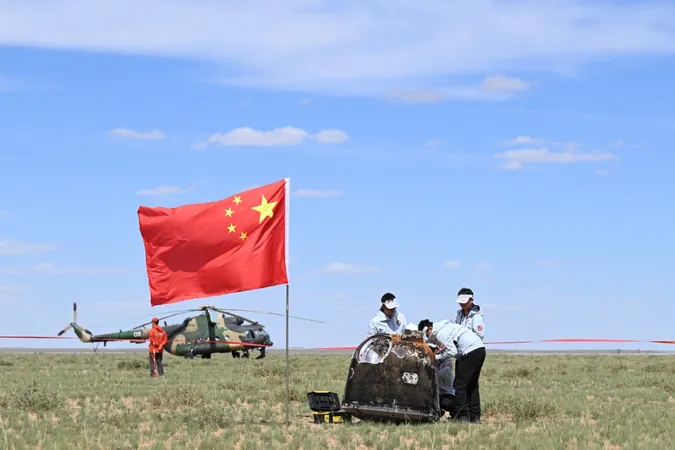
China's Lunar Legacy: Bridging Earth and Space in a New Era of Exploration
2025-06-29
Author: Charlotte
Once upon a time, the enchanting story of Chang'e’s moonlit journey was merely a piece of Chinese folklore. Today, that age-old myth has been reimagined into a vibrant reality, with moon samples now gracing the United Nations headquarters in Vienna instead of the palace of the moon goddess.
Celebrating 20 Years of Lunar Exploration
On June 25, during the 68th session of the UN Committee on the Peaceful Uses of Outer Space, China celebrated a monumental milestone: 20 years of lunar exploration. The nation hosted an exhibition featuring lunar samples from both the moon’s near and far sides, serving as a testament to its extraordinary achievements in space technology. This event not only illustrates China's scientific prowess but also emphasizes its vision for inclusive and peaceful exploration beyond our planet.
China’s Lunar Landmarks: A Journey of Scientific Triumphs
The lunar samples—collected by the impressive Chang'e-5 and Chang'e-6 missions—represent significant milestones in space research. Chang'e-5’s successful mission in 2020 made China the third nation to retrieve lunar materials, following in the footsteps of the US and the Soviet Union. Chang'e-6 took a bold step further, bringing back the first samples from the moon's mysterious far side in 2024, underlining China's relentless pursuit of exploration.
A Vision of Global Cooperation
However, the narrative of China's space program transcends mere national pride. The exhibition's underlying message is clear: China's pursuit of space exploration is open to all. The Chang'e endeavors have evolved from isolated missions into a shared journey, with China actively seeking cooperation over the past two decades. The Chang'e-6 mission, for instance, included scientific instruments from France, Italy, Pakistan, and the European Space Agency.
Lunar Samples: A Shared Treasure for Humanity
In a groundbreaking move, China has committed to sharing its lunar samples with the world, emphasizing that these treasures belong not just to one nation but to humanity as a whole. This philosophy showcases China’s dedication to fostering international collaboration in space under principles of equality and mutual benefit. In an era where geopolitical tensions can often plague space ambitions, China's call for multilateral cooperation sends a hopeful and constructive message.
Beyond the Moon: China’s Pioneering Space Journeys
China’s accomplishments in space extend well beyond lunar missions. The nation etched its name in history with the Tianwen-1 mission to Mars, launched in July 2020, marking its first independent venture into interplanetary space. This pioneering mission successfully deployed an orbiter, lander, and rover on the Red Planet, all in a single launch—an unprecedented feat.
Opening Doors for Global Participation
Additionally, China operates two advanced solar observation satellites, offering groundbreaking discoveries about the sun's behavior. In a remarkable stride towards collective exploration, China has proposed an open and inclusive platform for deep-space missions, inviting countries of all sizes to collaborate. Cooperation agreements with 17 nations and international organizations for building the International Lunar Research Station showcase this commitment to global partnership.
Towards a Shared Human Future in Space
With the first set of experimental projects selected through partnerships with the UN Office for Outer Space Affairs actively ongoing aboard the Chinese space station, what once felt like a distant legend is transforming into a shared narrative of humanity’s journey into the cosmos. As we look toward the stars, China's space initiatives illuminate a path of cooperation, exploration, and shared destiny among all of Earth's inhabitants.









 Brasil (PT)
Brasil (PT)
 Canada (EN)
Canada (EN)
 Chile (ES)
Chile (ES)
 Česko (CS)
Česko (CS)
 대한민국 (KO)
대한민국 (KO)
 España (ES)
España (ES)
 France (FR)
France (FR)
 Hong Kong (EN)
Hong Kong (EN)
 Italia (IT)
Italia (IT)
 日本 (JA)
日本 (JA)
 Magyarország (HU)
Magyarország (HU)
 Norge (NO)
Norge (NO)
 Polska (PL)
Polska (PL)
 Schweiz (DE)
Schweiz (DE)
 Singapore (EN)
Singapore (EN)
 Sverige (SV)
Sverige (SV)
 Suomi (FI)
Suomi (FI)
 Türkiye (TR)
Türkiye (TR)
 الإمارات العربية المتحدة (AR)
الإمارات العربية المتحدة (AR)